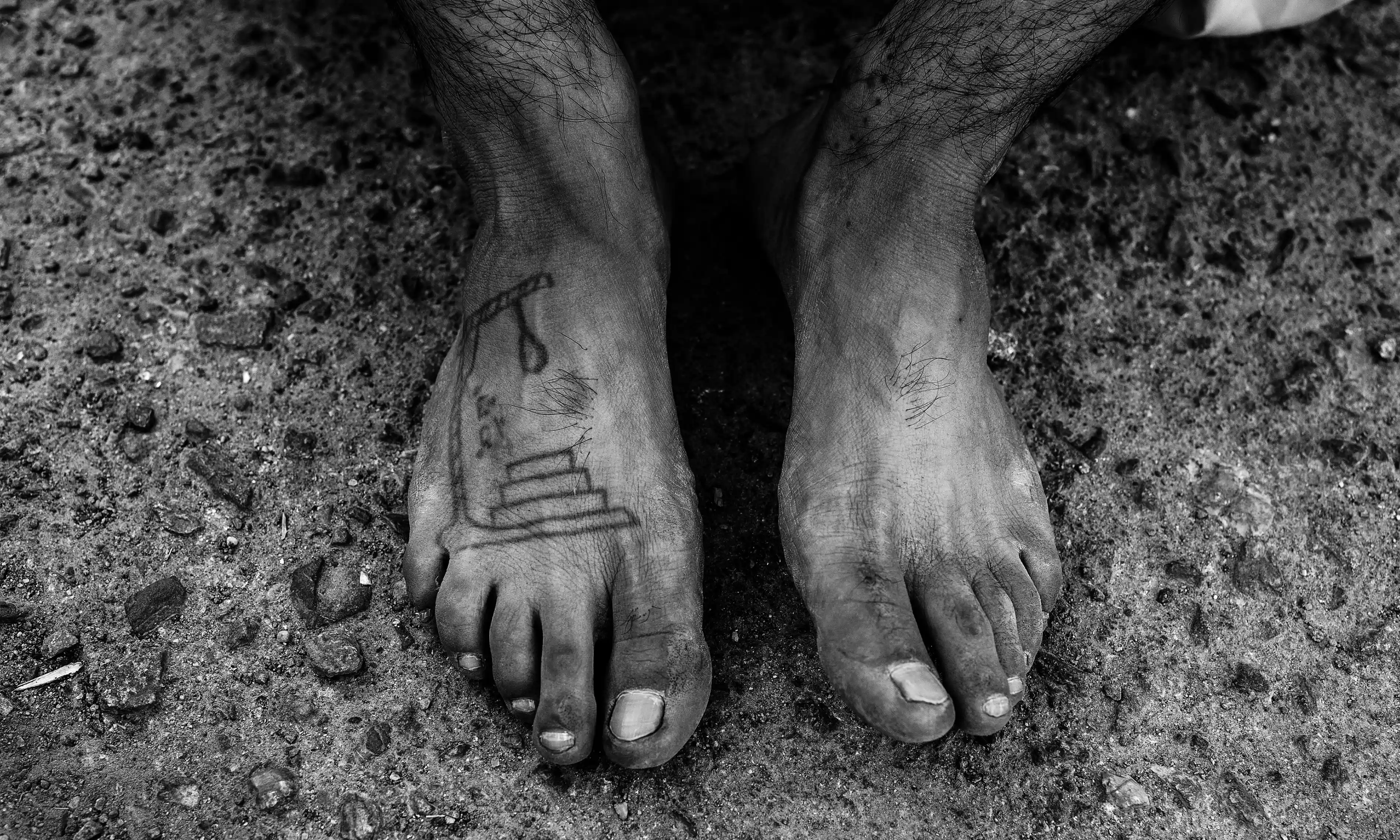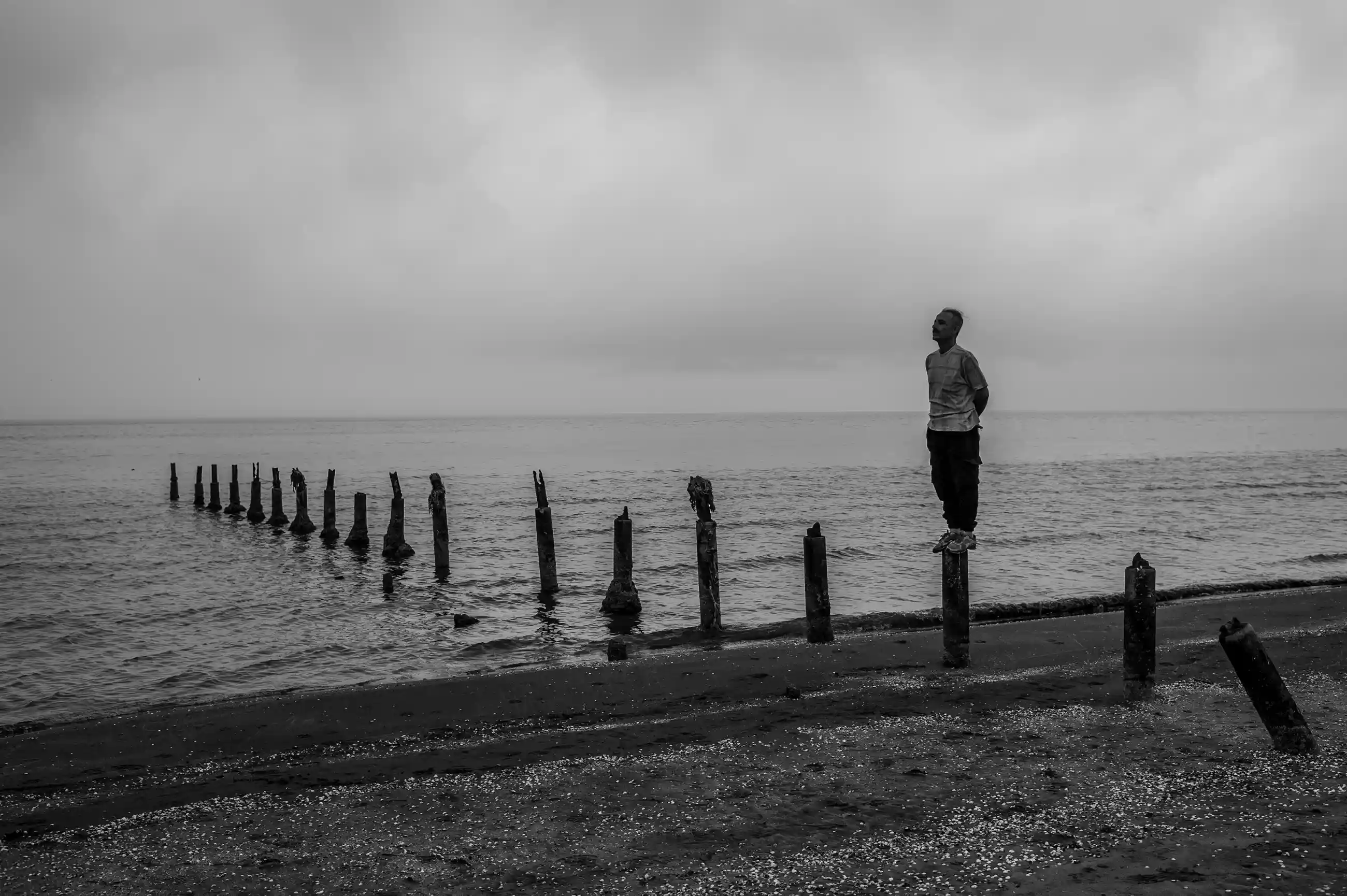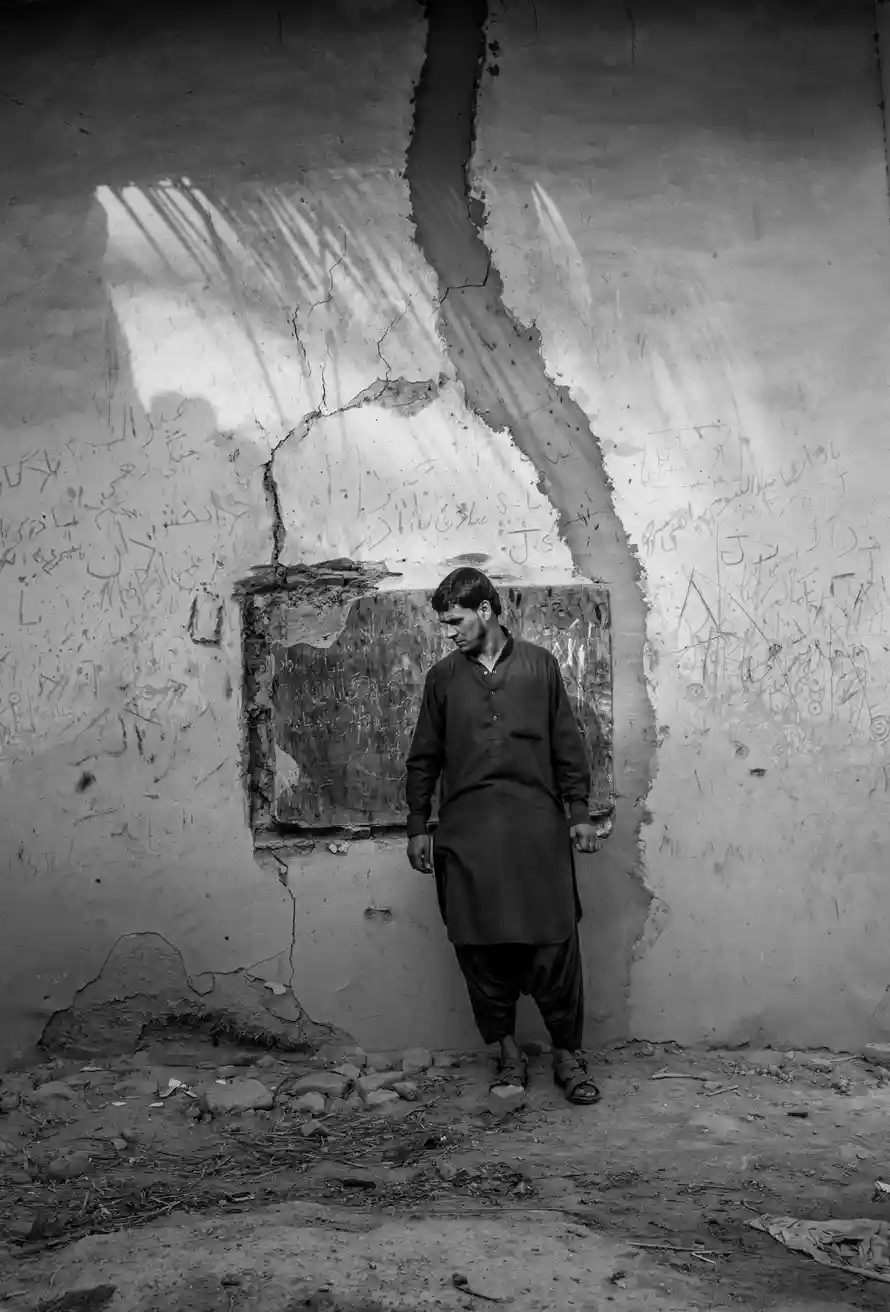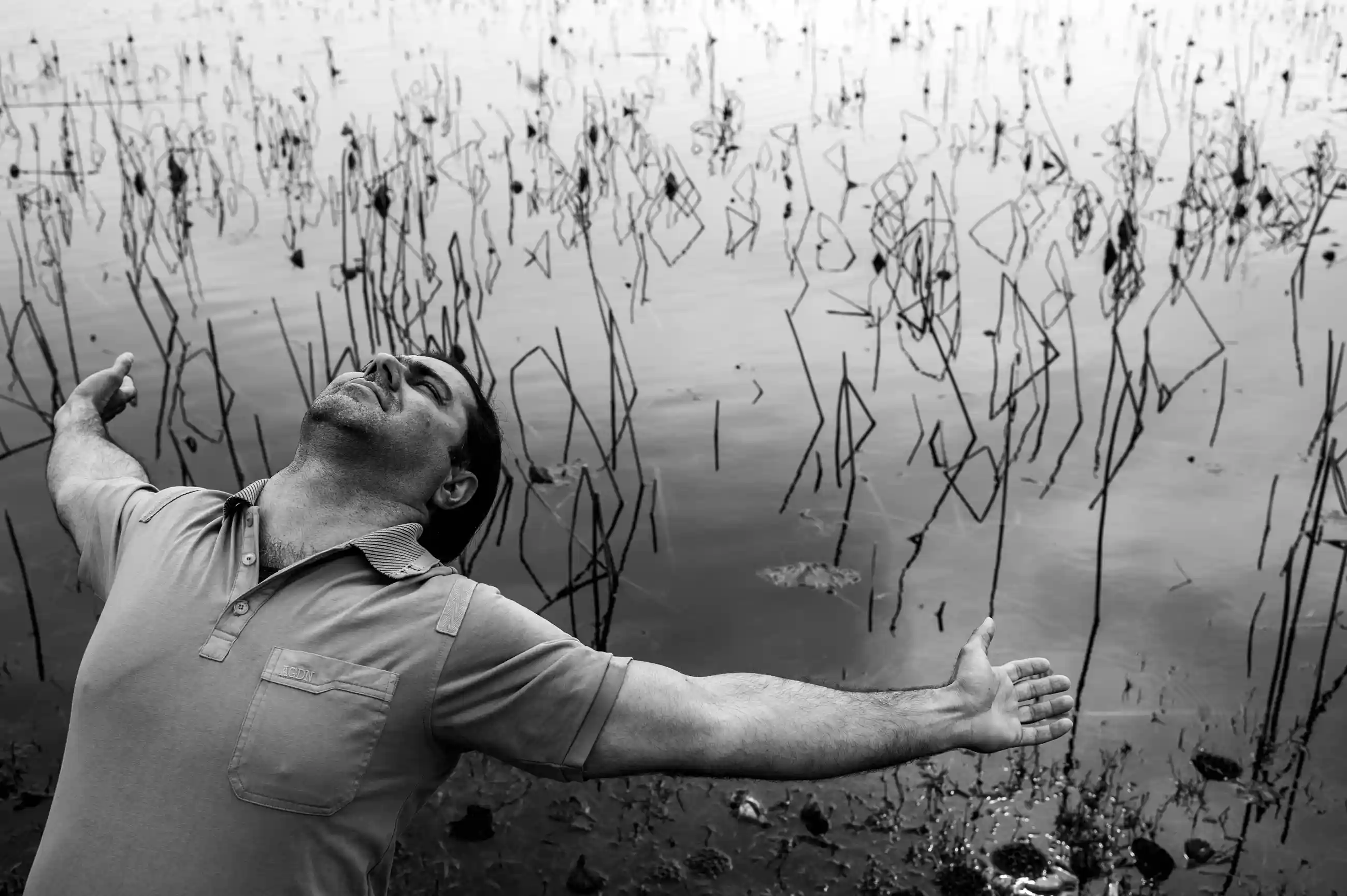
A tattoo of gallows memory of a friend who was hanged. Iranranks second for the total number of executions, after China, and first for per capita executions. Photograph: Enayat Asadi
A random encounter led a photographer to document murderers once on Iran’s death row, where inmates can be reprieved, often at the gallows, but only if they can pay blood money
Thu 10 Nov 2022-The Guardian- by Ramita Navai. Photographs by Enayat Asadi –
Athick, crisp layer of snow covered everything in sight. A sheet of white, broken only by a sludge-smeared two-lane road that cut through the landscape like a knife parting a wedding cake. Enayat Asadi was miles from the nearest town; the photographer had not seen another soul for hours.
He had spent nearly a year travelling the hinterland, across deserts and mountains to remote villages and isolated communities. He was working on a personal project called ranj (suffering), chronicling the hardships and misfortunes of those hidden from view. Now he was in the south of the country, a few hours west of Isfahan, where the ruined forts scattered the earth and where the winter froze rivers and waterfalls to a silvery crust.
Asadi was not surprised when an old Paykan car going past stopped. A person walking in the cold far from shelter was a rare sight. Asadi accepted a lift from Rahmatullah, a warm man with a weathered face, wearing a traditional patterned woollen overcoat and ankle-skimming, wide-legged trousers. Rahmatullah, 57, took Asadi on a six hour tour of the area, its breathtaking beauty belying its inhabitants’ struggle to provide for hungry children.
Rahmatullah had also been on the road for many months, in a slow race against time. Rahmatullah’s son had killed a man in a fight and had been sentenced to death. He had been awaiting execution for 12 years; he had one chance of survival.

Rostam, 50, shows the site of a gallows, on the rotten foundations of an old pier. When he was 24, he and two accomplices killed an old man and woman during a burglary. He was put on death row at the age of 35. His accomplices were executed and he saw them hanging. After 20 years in prison, he was finally pardoned on the day of his execution after paying a ransom to the victim’s family. He was arrested a year after his release on charges of armed robbery. His wife divorced him. He has a son, but no family members will see him. He is now on parole
Rahmatullah’s son had been sentenced to qisas (retribution in kind), where under Iran’s sharia law the victim or the victim’s family are given the power to punish the culprit based on an “eye for an eye”. The family are expected not only to watch but can assist with the hanging. They also have the power of clemency.
After years of negotiations, the family of the man Rahmatullah’s son had killed had agreed to formally forgive him: to halt the execution in return for “blood money”. Rahmatullah had already sold everything he owned but it was not enough.
“Rahmatullah cried telling me about his desperate mission to save his son, going from village to village, meeting with elders, trying to raise money. It was a terrible situation. I wanted to cry with him,” says Asadi. “But the story triggered old memories for me. I also had tears for my own past.”
Asadi spent his childhood on the move with his military father. Every summer the family would return to Gorgan, their home town near the Caspian Sea. Days would be marked by family gatherings and teenage boredom. One summer, aged 17, Asadi met two boys who became his best friends.
 |
 |
Hamid, 26, in the yard of his parents’ rented house. Aged 20, he shot and killed a neighbour for insulting his parents and was sentenced to death. He was put on death row at the age of 24. His parents had to sell their house to pay blood money, and left the city for ever
Arshad, 33. Aged 26, he shot a young Afghan man during a robbery at the home of a refugee family. He was a fugitive for four months in Karachi, Pakistan. After returning to Iran, he was arrested for carrying weapons and then sentenced to death for murder. He says he kept asking to be executed sooner because he could not bear the stress and told his family to prepare his shroud. He was released last year after paying a ransom. He is now unemployed
Abbas and Mazaher were both tearaways who lived by the law of the street. They were as curious about Asadi – this mild-mannered, middle-class boy – as Asadi was about them.
Summer nights were spent roaming the town itching for parties and trouble. They took him to places that throbbed with anticipation and danger. They danced and laughed and survived scrapes.
Asadi’s worried family could not persuade him to abandon these hoodlums.Asadi liked the gangsters’ swagger and their talk. He was moved by their unwavering loyalty to those they trusted. A deep friendship was forged.

Mehdi, 38. When he was 22, and returning from a party with his pregnant wife, he got into a row with a motorcyclist and stabbed him dead. He was sentenced to death, and put on death row three times during 13 years in prison. He was forgiven on the day of his execution, after paying a ransom. ‘Moments before the execution, I wished the time would stop and the clock would not move.’ His wife left him and their four-year-old child, four years after he was imprisoned. His child grew up with his parents. A year after his release, he remarried and now has a two-year-old daughter
In adulthood, they grew apart as their lives took different paths, but the ties of affection remained. Asadi was not surprised when he heard that his friends had graduated to more serious crimes. Mazaher killed a man during a carjacking. Not long after, Abbas robbed a gold shop and then a bank with a group of criminals, shooting the shopowner dead.
Abbas was executed within a month – hanged in a football stadium, watched by thousands of spectators. Mazaher spent seven years on death row. His family could not afford the blood money to save him and the victim’s family wanted retribution, so he was hanged in prison.
“They did bad things. But they were products of their environments. They came from poverty. It was a hard life where different rules apply,” Asadi says. All these years later, he still cries.
“Rahmatullah brought it all back. But Abbas and Mazaher are always there in the back of my mind.”

Rahmatullah, 57, trudging through the snow as he visits villages in a desperate quest to raise the money to save his son
Asadi took photographs of Rahmatullah that day: walking in the desolate landscape on his solitary quest to save his son. Asadi’s time with Rahmatullah affected him deeply.
It was another chance meeting in 2021 that made him decide it was time to face his past. Visiting a gallery in a Caspian port town, he met a prison social worker who had worked on death row. He spoke of the trauma of mock executions, of sentences commuted at the last minute when nooses had already been placed around necks. He described the ad hoc methods: men hanged from trees or basketball hoops when gallows were not available.
Advertisement
The social worker and prison guards mediated between the inmates and the families of the victims, trying to persuade them to forgive, to accept blood money. Even senior prison officials fought to save prisoners from death.
Iran has the world’s second-highest execution rate, with human rights groups reporting that capital punishment doubled after the hardline cleric Ebrahim Raisi was elected president last year. Exact figures are hard to obtain, but since the Oslo-based organisation Iran Human Rights began recording executions in 2010, 6, 876 prisoners have been executed and 705 who were sentenced to death have been forgiven under the qisas system.
In cases of injury or accidental death (mostly car crashes), the victim’s family can forgive the accused in return for government-set compensation, known as diyeh. If a victim is a woman, the diyeh is half that paid for a man. Until a few years ago, the female victim’s family had to pay the deficit, but that is now paid by a state-funded trust.
With murder, the victim’s family are entitled to qisas – to either request the perpetrator is executed or to forgive them. In nearly all cases where the accused is forgiven, blood money has been paid, with the amount set by the victim’s family.
A bearded man seen in profile while driving
“Forgiveness is a noble act, but qisas is a horrible practice. It’s cruel to put that burden of responsibility on the family of the victim. Prisoners can languish for years without knowing what’s going to happen to them,” says Shahin Milani, the executive director for the US-based Iran Human Rights Documentation Center.
“Convicts from wealthier families are more likely to be spared because they can afford to pay the victim’s family, so that they would forgo qisas. It becomes about class and wealth. The whole system of punishment is arbitrary and unequal.”
For the prison social worker, qisas system was the only hope his prisoners had.
A bearded man in an astrakhan hat gazes into the distance as gulls fly above him
“As the social worker spoke, all I could think about was Abbas and Mazaher and the horror they had gone through. All that pain came back. That meeting sparked something in me,” says Asadi. “I was ready.”
With the help of the social worker and some of the families he had met during his years documenting the marginalised, he travelled Iran finding those who had survived death row, forgiven in return for blood money. He wanted to examine what it was like to live under the shadow of death – of those you had killed, and of your own.
More than 100 former prisoners turned him down, and most of those who agreed to be photographed requested anonymity. Sometimes, he would travel thousands of miles to meet someone, only to be turned away.
A thin-faced man is seen through a rainy windscreen
The men Asadi went on to meet were from poor, working-class families. Paying the blood money left nearly all of them destitute.
Bagher, a greengrocer, was 28 when he shot his wife dead in the street for having an affair with his friend. He was sentenced to death but released seven years later after paying a particularly high sum of blood money.
Bagher’s father-in-law had been executed for drug dealing – a crime for which qisas does not apply.
As Asadi and Bagher shared a kebab supper, Bagher wept, saying he could not forgive himself for killing his wife.
Mehdi was a 22-year-old teacher driving home after a party with his pregnant wife when he got into an argument with a motorcyclist. In a fit of road rage, Mehdi stabbed the man to death. He was nearly executed three times. He was at the gallows when he heard his victim’s family had forgiven him in return for money. It took 13 years before he was released, during which time his wife left him, because 22 members of the victim’s family had to agree and settle on the amount to be paid.
Most of the men Asadi spoke to needed forgiveness in order to move on with their lives. But a few did not. The father of Javad and Reza had all three of his sons on death row – a criminal family they moved in a violent world. His sons had all killed in street fights. The blood money was a straight transaction and they needed no absolution.
Asadi felt compassion for everyone he spoke to, despite the terrible things they had done. “Of course the men should have been punished. And some should have spent longer in prison. But they all live with guilt – and that guilt never leaves,” he says.
“All these men have been given a second chance at life. They are allowed to live again. I think of Abbas and Mazaher, and I know they should be in prison for what they did – I just wish they were still alive,” Asadi says.
“I’d give anything for them to be able just to breathe again. That would be enough.”
Sign up for a different view with our Global Dispatch newsletter – a roundup of our top stories from around the world, recommended reads, and thoughts from our team on key development and human rights issues, delivered to your inbox every two weeks:
